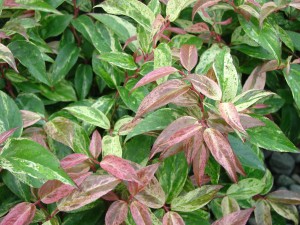Mountain doghobble (Leucothoe fontanesiana) is native to woodland areas in the Southern Appalachian region (USDA zones 6 and 7). Florida coast leucothoe (L. axillaris) is another regional favorite, native from Virginia south to Florida. Over time it grow tall, usually 3-4 feet high as a rambling ground cover. Every 3 to 4 years hand pruning is needed to hold doghobbles to a desired location and height.
In nature doghobbles grow in acidic, well-drained, organically rich soil, often in close association with other U.S. native acid-loving shrubs such as rhododendrons, azaleas, and mountain laurels (Kalmia spp.) and selected ferns. Soil pHs in the range of 5.0 to 5.5 are preferred. Two-year established plants exhibit good drought tolerance; newly planted doghobbles require periodic watering when seasonal moisture is not plentiful from rain or snow. Mulching is often beneficial. Established plants rarely require fertilizing; use an acidifying fertilizer such as Miracle-Gro™ or Schultz™ as needed.
Doghobble is dominant under dappled or partial shade and grows less vigorously under deep shade. Florida coast will grow in full sun under good moisture. Both species are excellent choices as a shrubby ground cover planted under landscape shade trees, areas formerly occupied by ground hugging junipers. Often, new landscapes are bathe in full sun, but sun-loving ground covers like cotoneasters and junipers decline as the trees cast more shade.
Doghobbles produce creamy white fragrant flowers in May; their slight fragrance filters through their small space over the 2-3 week bloom time. Doghobbles are mostly insect and disease resistant, but leaf spot problems may occasionally ramp up in wet hot summers. Florida coast doghobble appears to be more leaf spot resistant than mountain doghobble.


 Posted in
Posted in 
